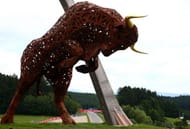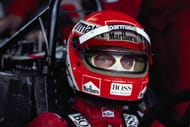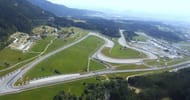With the Grand Prix of Austria set to begin with practice sessions on Friday, the 19th of June 2015, we bring you some interesting facts in the history of the race:
-
The track only returned to the Formula One Calendar in 2014
Located in Austria, Spielberg, the Österreichring is built through the mountains of Styria, with several high speed corners and sectors. It is these sectors that caused the FIA to deem it ‘too dangerous’ in 1987, when officials were forced to restart the race due to multiple accidents on the narrow pit-straight. Nigel Mansell won that race, and his teammate Nelson Piquet came in second. That would be the last race for a decade. The 2014 winner was Mercedes’ Nico Rosberg – and this was Mercedes’ first win at the Austrian Grand Prix.
2. It’s now named after Red Bull
And there’s a sculpture to prove it! Previously known as the Österreichring – literally, the ‘Austrian circuit’, it was renamed the A1 Ring in the 1990s. Safety concerns had led authorities to call for reconstruction at the track, and it was demolished and rebuilt by the iconic German engineer Hermann Tilke, who is known for having designed several Formula One circuits. Cellular service provider A1 was the chief sponsor for the refurbishment of the track, and this led to it being renamed the A1-Ring.
2004 saw the track’s pits and grandstands razed, which meant that it could not be used to race under any circumstances, for any motorsport.
Although Red Bull denied rumours at first, it took the track, beginning the €70m reconstruction in 2008. The team put forth a proposal in 2013 to reinstate it into the F1 calendar, and made its comeback the following year. The wrought iron artwork symbolising the team looms imposingly over the track.
3. It is known for its close finishes
Of the 28 races held at the track, 11 have been won with a margin of less than 5 seconds, with more than half the races won under 10 seconds, 16 to be exact. The smallest margin of victory in the history of the track came in 1982, when Italian driver Elio de Angelis, then driving with Lotus, won the Grand Prix, beating the Williams of Finnish driver Keke Rosberg by a miniscule 0.05sec. It is easily one of the most exciting F1 finishes in history.
This would go on to be the fourth closest F1 finish of all time. The closest was at the 1971 Italian Grand Prix, where British driver Peter Gethin won by a mere 0.010 sec, with the top 5 at that race all finishing within 0.61 seconds of each other.
-
Only once has a home driver won
That would be racing legend Niki Lauda, who won the 1984 Grand Prix. He had won pole three times before this, but failed to bring this to fruition. Of eight races held at the newer track, polesitters have only won a total of three times.
-
It’s the shortest race of the year
The Osterreichring, now the Red Bull Ring, started out being 5.9km long, but this was shortened to a little over 4.3km when the track was redesigned by Hermann Tilke in 1997, and remains that length. It is not the shortest race in terms of distance – that title is with Monaco, at 3.37km, and Brazil, at a little under 4.3km just under the Red Bull Ring.
However, due to its high speed straights, the Red Bull Ring is the shortest in terms of lap time.



